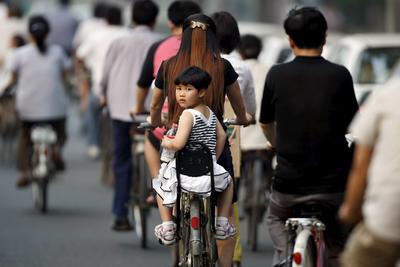China’s working population is currently around 840 million. The working component of the population will rise in the next decade to around 910 million but will then decline very rapidly to around 790 million by 2050.The most dramatic change is the explosion of the over-65 population, and the decline in the share of the young. China’s median age will climb over this period from around 24 to around 45.
The projected democratic transition has enormous implications for economic policy strategies, social institutions and social life as well perhaps for the character of the Chinese polity. For one thing, demographic crunch will affect the speed with which the pressures of the so called economic ‘turning point’, after which China can rely less and less on its supplies of low cost labour, begins to bite on international competitiveness. For another, there is the massive task of preparing the welfare system to take care of an ageing population with less and less family support.
What’s less well know is the growing gender imbalance in China’s population, induced by a huge rise in male over female births, or what demographers call the sex birth ratio.
Zhao and Chen, this week, argue that the growth in gender imbalance is one of the most worrying demographic trends taking place in China. In most populations the sex ratio at birth, measured by the number of male live births per hundred female live births, varies between 103 and 107. In the 1960s and 1970s this used to be the ratio in China too. But by 2000 it had climbed to 116.9 and, since 2004, it has hovered around 120. If a sex birth ratio of 107 is assumed normal (a generous assumption, between 1982 and 2010 nearly 20 million more males than females have been born in China. There is no sign that this pattern will return worldwide norms. The number of excess males will continue to grow over the next one or two decades.
The rising sex ratio is clearly associated with stricter enforcement of the one-child policy through the 1980s and, as Zhao explains, entrenched social, cultural and institution traditions that favour male heirs.
The implementation of family planning policies is fast becoming a major national scandal with child abduction, child trade and ‘social compensation’ payments to corrupt local officials for violation of the one child policy.
The growing gender imbalance is an unfortunate and unintended consequence of engineering the contraction of China’s population. It will have a big impact on China’s future demographic and social development. The imbalance of males and females in the marriage market will be intense with many unwelcome social and psychological consequences. The pressure to reverse or ease family planning policies grows year-by-year.
While Chinese government and society need to take action to restore a more normal sex birth ration, as Zhao warns, they face a complex question, where cause and consequence can’t easily be unraveled and the impact on economic, political, social and even security issues of trying to manage this problem, like trying to manage the one that led to it, cannot be predicted with much confidence or certainty.
Peter Drysdale

